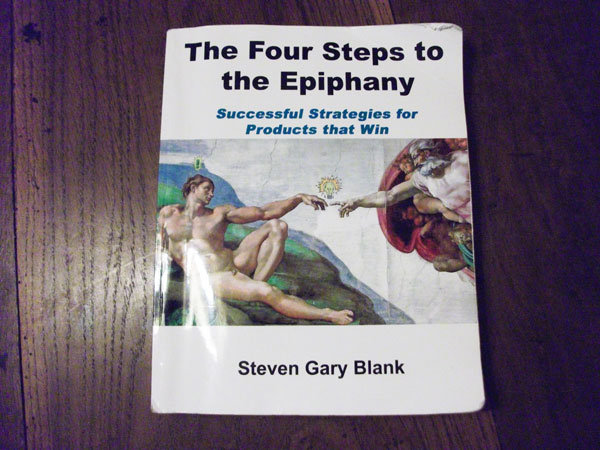The Four Steps to the Epiphany

Introduction
I recently got hold of a copy of The Four Steps to the Epiphany - that’s right, a real copy!
For people who haven’t heard of this book, it’s a fairly obscure title which you won’t find on the shelves of book stores - it’s print on demand only, and contains the condensed wisdom of a seasoned entrepreneur turned Stanford lecturer called Steve Blank, whose approach to product development has gained enormous traction in the startup community.
Lean startup
The book was the genesis of the whole Lean Startup movement which prioritises getting market traction as early as possible as a means of validating demand for a new product.
This contrasts with traditional product development processes where a product is developed in its entirety before being launched into the market place, before which any customer contact is minimal, and the likelihood is that the product won’t meet with strong demand and will fail.
Beyond the first two chapters
There’s a running joke in the Lean Startup community that even the most ardent practitioners of Lean Startup principles haven’t read more than the first two chapters of Four Steps to the Epiphany.
Sure, there’s a lot of wisdom in the first couple of chapters, which can be condensed into ‘get to know your customers as early as possible’, but what about the rest of the book?
I started re-reading the book this weekend, and there’s a lot of details which are easily skipped over or forgotten.
Not all startups are the same
One thing which struck me was the observation that not all startups are the same.
This might sound like an obvious insight - like saying no chicken is the same as any another chicken.
However, as human beings we have a tendency to view things as abstract groups because it simplifies things. But believing that all startups are the same, and require the same cookie cutter approach is a misguided view.
Subgroups
Steve Blank breaks down startups into the following subgroups:
- Startups bringing a product to an existing market.
- Startups bringing a product to an new market.
- Startups bringing a product to an existing market, and trying to re-segment that market as a low cost entrant.
- Startups bringing a product to an existing market, and trying to re-segment that market as a niche entrant.
Knowing which group you’re in
It’s really important to know which camp your startup belongs to because it fundamentally effects what your value proposition and customer acquisition strategy should be.
For instance when entering a new market, your competitors are likely to be other startups, and the customer acquisition strategy will likely focus on educating new users rather than competing for the business of an existing customer base.
I don’t want to rehash the contents of the book, especially in the space of a blog article. However, the insight about different types of startup is pivotal to a proper understanding of Four Steps.
The whole purpose of Four Steps is to help formulate repeatable strategies for introducing new products. But strategies which work in one type of startup (e.g. entering an existing market) are completely different to those which work in another type of startup (entering a new market).
Conclusions
The problem with Lean Startup now is it has become a bit of a buzzword, with terms such as ‘customer development’ being thrown around, and used in a very simplistic sense.
If you haven’t read Four Steps then I really recommend reading it. And if you’ve just read the first couple of chapters (like I had), go back and read the rest of the book. Understand how customer development is different for different types of startups. Otherwise you might fall into the trap of applying the same methodologies which worked in one business type to a completely different type of business.
What distinguishes great companies like Apple, and great entrepreneurs like Elon Musk and Marc Andreessen is their ability to repeatably bring successful products to market. As entrepreneurs and product developers hopefully we can get closer to those kinds of standards by using more intelligent product development strategies like those outlined in Four Steps.
Further materials
- Steve Blank interviewed on Dorm Room Tycoon podcast about applying the customer development model.
- First two chapters of Four Steps
- A popular Lean Startup blog.